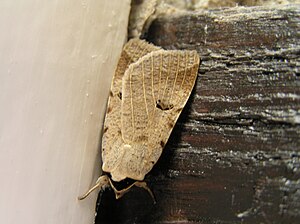Edge patch paddling owl
| Edge patch paddling owl | ||||||||||||
|---|---|---|---|---|---|---|---|---|---|---|---|---|

Lygephila craccae ( Lygephila craccae ) |
||||||||||||
| Systematics | ||||||||||||
|
||||||||||||
| Scientific name | ||||||||||||
| Lygephila craccae | ||||||||||||
| ( Denis & Schiffermüller , 1775) |
The edge spot Wickeneule ( Lygephila craccae ) is a butterfly ( moth ) from the family of cutworms (Noctuidae). The specific epithet is derived from the main food plant of the caterpillar, the bird vetch ( Vicia cracca ).
features
butterfly
The wingspan of the moth is 40 to 44 millimeters. The color of the upper sides of the wings varies from light gray to gray-violet or gray-brown to dark gray. On the front edge of the forewings, three to four dark spots stand out clearly. The transverse lines are indistinct. The dark brown kidney flaw is narrow. A ring flaw is usually missing, and in some specimens it is only recognizable as a black dot. The veins are brightly dusted. The back of the head and neck are noticeably hairy black-brown and velvety.
Egg, caterpillar, pupa
The egg is spherical and initially has a light yellowish brown color, which later changes to pink with a greenish band in the upper part. It is deeply troughed at the bottom of the egg and covered with about 30 strong, straight longitudinal ribs, almost half of which reach the micropyl zone .
Adult caterpillars are gray-brown or gray-green in color. The fine line of the back is dark brown. The wide side stripes are also dark brown. There are white, black-pitted point warts on the entire surface of the body. The gray-brown head is latticed dark.
The red-brown doll has numerous curved bristles on the wrinkled cremaster .
Similar species
In the very similar marbled wicked owl ( Lygephila viciae ), the spots on the front edge are smaller or absent. The large, dark, but usually somewhat indistinct or blotchy kidney defect is cut through by the brightly dusted veins.
distribution and habitat
The distribution area of the Randfleck-Wickeneule extends from southern and western Europe through Central Asia to China and Japan . In the Southern Alps, the occurrence extends to altitudes of 1,800 meters. The species primarily inhabits warm, stony slopes, forest edges, clearings, rocky heaths and wastelands. It occurs preferentially on limestone soil.
Way of life
The nocturnal moths fly in two generations in May and June and in July and August. You visit artificial light sources and baits . The caterpillars prefer to feed on the leaves of the bird vetch ( Vicia cracca ). Other food crops include forest Vetch ( Vicia sylvatica ) Kronwicken ( Coronilla ), bear pepper ( Astragalus glycyphyllos ) and Spring Pea ( Lathyrus vernus ). The species overwinters as an egg.
Individual evidence
- ^ Arnold Spuler: The butterflies of Europe , Volume 1, E. Schweizerbart'sche Verlagsbuchhandlung, Stuttgart (E. Nägele), 1908
- ↑ Barry Goater, László Ronkay, Michael Fibiger: Catocalinae & Plusiinae. Noctuidae Europaeae, Volume 10., Sorø, 2003, ISBN 87-89430-08-5
- ^ A b Walter Forster, Theodor A. Wohlfahrt: The butterflies of Central Europe. Volume 4: Owls. (Noctuidae). Franckh'sche Verlagshandlung, Stuttgart 1971, ISBN 3-440-03752-5 .
- ^ Günter Ebert: The Butterflies of Baden-Württemberg Volume 5, Moths III. Ulmer Verlag Stuttgart 1997. ISBN 3-800-13481-0
- ↑ a b c Manfred Koch : We determine butterflies. Volume 3: Owls. 2nd, expanded edition. Neumann, Leipzig / Radebeul 1972, DNB 760072930 .
literature
- Barry Goater, László Ronkay, Michael Fibiger: Catocalinae & Plusiinae. Noctuidae Europaeae, Volume 10., Sorø, 2003, ISBN 87-89430-08-5
- Günter Ebert: The Butterflies of Baden-Württemberg Volume 5, Moth III. Ulmer Verlag Stuttgart 1997. ISBN 3-800-13481-0
- Walter Forster , Theodor A. Wohlfahrt : The butterflies of Central Europe. Volume 4: Owls. (Noctuidae). Franckh'sche Verlagshandlung, Stuttgart 1971, ISBN 3-440-03752-5 .
Web links
- Lepiforum e. V. - Taxonomy and photos
- www.leps.it - Moths and Butterflies of Europe and North Africa
- funet.fi - dissemination